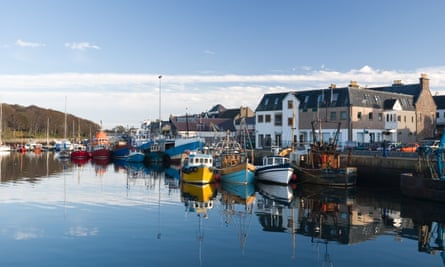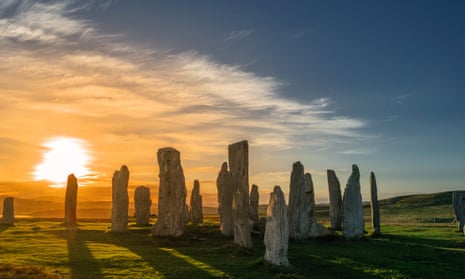First light at Callanish. The stone circle on the Hebridean island of Lewis may be 5,000 years old, but it would not do to keep it waiting. Besides, coming here at daybreak is, from certain perspectives, positively tardy. Emma Rennie, a local photographer, considers 2am the best time to visit. “It’s beyond mindblowing,” she told me, ahead of my journey. “There’s silence, which the world is so short of nowadays, and millions of stars. I feel small and insignificant, and I love it.”
Callanish – or Calanais in Gaelic – comprises 49 standing stones laid out in a shape that, seen from above, suggests a Celtic cross. Despite this resemblance, the site long predates Christianity and, indeed, Stonehenge. The drama is heightened by its location on a ridge above a loch. You can gaze across the water to other prehistoric sites nearby – Calanais II and Calanais III. Like Led Zeppelin albums, the stone circles around here are numbered, and they are heavy. The central monolith at Callanish is almost five metres tall and weighs around 4½ tonnes. It has a pelt of lichen in pistachio green.
This is one of the delights of Callanish, and something you can’t get from the photographs – the look of the stones up close, and the tingling pleasure of the way they feel beneath your palm. Swirls, crevices, bright patches of pink granite … each stone offers a drone’s-eye view of some desert landscape. The oystercatchers and swallows, peeping and piping overhead, have the right idea. Don’t get too close: you could get lost in those patterns and never find your way out again.
What, though, was Callanish for? The idea that this was some sort of druidic temple draws the crowds, especially at the summer solstice. The visitor centre and information panels play it safe with a lot of “perhaps” and “possibly”; the purpose of the stones, they say, remains a mystery. When I visit Callanish expert Margaret Curtis at her home nearby, she offers greater certainty: the site, she believes, was built as a solar and lunar observatory.

“Be careful of the hairy caterpillars, won’t you?” she says, leading the way through her garden to the exhibition space in an outbuilding where she can better explain her theories. The caterpillars, which have white mohicans, drop from nettles and scoot out of the way as we pass. Curtis is 78, with white pigtails and star-patterned wellies, and has devoted much of her life to the study of the island’s prehistoric sites.
Brought up in Warwickshire, she moved to Lewis in 1974, fed up with the urbanisation of the English countryside. She and her young children would take long walks, getting to know the landscape, and in this way developed a knack for finding long-lost standing stones. She discovered the broken tip of one of the Callanish stones being used as part of a wall, located another stone missing from the site’s eastern arm lying beneath the peat, and once identified an unrecorded stone circle while going into Stornoway, the island’s biggest town, on the bus to do her shopping. “That,” she says, “was quite nice.” Curtis is firmly in favour of Callanish getting Unesco world heritage listing – “to recognise the ability our forefathers had” – but she herself might be considered a treasure of the island.

There are others. The Lewis chessmen for one. These are the most precious archaeological objects ever found in Scotland. The 12th-century figures were dug from the island’s Atlantic coast in 1831. Despite a recent theory that they originated in Iceland, the academic consensus remains that they were made in Trondheim, Norway. How they came to be in Lewis, no one knows. The mystery is part of their magic.
Thanks to a long-term loan from the British Museum, six of the pieces are on display at the Museum nan Eilean in Stornoway: king, queen, bishop, knight, pawn and warder (a rook in modern-day chess). They are the colour of tobacco-stained teeth, and are made from walrus tusks. Tiny grooves in their surface are thought to be marks left by insects burrowing in the island’s white sand.
Most striking of all are the facial expressions. The bishop, deep in thought, grasps a crozier. The queen, right hand to her cheek, has the look of saucer-eyed ennui familiar to any woman who has ever been sent an unsolicited photo of an intimate nature.

This sense of a living personality is one reason why the chessmen move us. But there is something more. They are a tangible link to the people of the past and, because they are gaming pieces, they speak of human pleasure and intellect. The men and women who played with these were, perhaps, not so different from ourselves. It is easy to imagine them being held by hands that have themselves long turned to bare bone.
Yes, there are Lewis chessmen on display in London and Edinburgh, but it is far better to see them here in Lewis – spotlit in their glass case – like watching your favourite band play a homecoming show. By way of an encore, I make the trip across the island to the spot on the west coast where they were found. Hooded crows, hunched on fenceposts, are monkish figures in feathery cowls. Peat stacks, drying out by the road, resemble beehive cells. The gorse shines bright as any illuminated gospel.
The volunteer-run Uig Museum (adult £1, child free) in Timsgarry has lots of interesting material on the chess pieces and other local history, and is only two miles from the place, near the village of Ardroil, where they were uncovered by a crofter, Malcolm Macleod. A wooden king more than two metres tall sits in majestic isolation next to a layby. Behind his throne there is a stile. Cross it and you are on the machair – the distinctive grassy dunes of the Hebrides – and then a great arc of white sand. The precise “findspot” is not known, which makes standing here, looking out over the waves, tantalising. What ivory monarchs might still lurk down there, awaiting restoration?

Back in Stornoway, a glimpse of contemporary life: the second annual Hebridean Pride festival. Unfortunately, the rain has worsened. What had been an invigorating spritz is now drizzle with menaces. Scarlet Skylar Rae, a drag queen from the mainland, is protecting her blond-and-pink wig with a Bible-black umbrella. A local woman, Lu, expresses her support for the occasion before being dragged off in the opposite direction by Banksy, a Newfoundland dog wearing a rainbow scarf round his collar. “If he wasn’t 10½ stone, we’d be marching,” she seems to say, as she recedes into the distance, dogwards.
At the front of the parade, local GP Dave Ripley is standing through the sunroof of a Hyundai, holding a rainbow flag aloft. He is wearing a silver dress and a tiara. “Priscilla Queen of the Hebrides” is written on the side of the car, which is pumping out Greased Lightin’ while proceeding at a stately 5mph. Imagine Delacroix’s Liberty Leading the People given a disco makeover. Passing the crazy golf, the bowling green, the fishing boats, it is a stirring sight.
Just a few years ago, the idea of having an event like this in Stornoway would have been unthinkable. Religious conservatism is still a significant part of the culture, and most shops and other businesses are closed on Sundays. But things have changed, and continue to do so.
The vice-chair of Hebridean Pride, Amanda Maclennan, and her wife, Kirsty, were the first lesbian couple to get married on Lewis. They had met and fallen in love while working in the local supermarket, which made them the talk of the town. “We were known as The Two Lesbians From Tesco,” Amanda recalls. Most gay people of her generation – she is 44 – moved away from the island, she says, because it was easier to be themselves elsewhere. But she felt unable to either leave or lie. “My choice was I lived as a lesbian or I didn’t live at all.”
To stay and be who you are, that is an act of faith. Lewis is, in many ways, an island of faith – literally and figuratively. In a secular society it offers the solid ground of belief. Those ancient stones at Callanish seem to express some sort of yearning for the numinous, and so too does the dour grey harl of the Free Church in Back, a few miles north of Stornoway.
I have come to experience a great tradition of the Hebrides – Gaelic psalm singing – while one still can. This village church is one of a few places where, every Sunday morning, this extraordinary sound can be heard.
The congregation numbers around 150. Men in dark suits and ties. Women in hats. The nave is flooded with pearly Vermeer light. Most of the service is in English, but Psalm 73 is sung in Gaelic.
Standing below the pulpit, the precentor leads – “Gidheadh, tha mise maille ruit …” – and the people follow. There is no accompaniment, just the human voice. The singing is slow, tidal, it swells and ebbs. These are songs of praise, full of God’s glory, but they ache with sorrow. This music sounds like Lewis looks and feels; it has that bleak beauty; tastes of earth and salt. This is a sound that has emerged from a culture of hardship, from subsistence crofting, when life and death were closer kin than they are now.
That, perhaps, is why this music seems to be on its way out: the congregations are growing ever older, ever smaller, and the music does not fit the present age. Calum Martin, a precentor at the church, is 66 and learned psalm singing as a little boy from his grandfather. He believes that within his lifetime those voices will be silenced.
“There isn’t a future as far as I can see,” he says. “Our traditional way of life is rapidly changing on this island, and once it’s gone it’s gone.”
This article was amended on 17 June 2019. The bishop from the Lewis chessmen is holding a crozier, not a mitre, as stated in an earlier version.
The Royal Hotel in Stornoway has doubles from £119 B&B. The Caledonian Macbrayne ferry sails to Lewis from Ullapool and Stornoway, from £19.50 return. Flights to Stornoway were provided by Loganair, which flies from various UK airports, including a new service from Southend, with a 30-minute stopover in Glasgow, from £105 one-way
Looking for a holiday with a difference? Browse Guardian Holidays to see a range of fantastic trips
